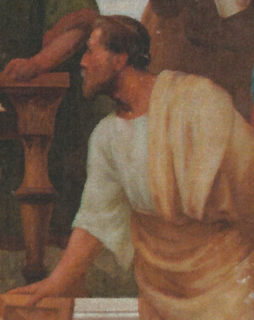 W
WAlexander of Tralles in Lydia and Caria of ancient Anatolia/Turkey. Alexander Trallianus, ca. 525– ca. 605) was one of the most eminent of the ancient physicians. His date may safely be put in the 6th century AD, for he mentions Aëtius Amidenus, who probably did not write until the end of the 5th or the beginning of the 6th century, and he is himself quoted by Paul of Aegina, who is supposed to have lived in the 7th century; besides which, he is mentioned as a contemporary of Agathias, who set about writing his History in the beginning of the reign of Justin II, about 565.
 W
WSaint Anastasia the Patrician was a Byzantine courtier and later saint. She was a lady-in-waiting to the Byzantine empress Theodora. Justinian I, Theodora's husband, may have pursued her, as Theodora grew jealous of her. Anastasia, to avoid any trouble, left for Alexandria in Egypt. She arrived at a place called Pempton, near Alexandria, where she founded a monastery which would later be named after her. She lived with monastic discipline and wove cloth to support herself.
 W
WFlavius Anastasius Paulus Probus Moschianus Probus Magnus was a Byzantine statesman who served as Consul in 518.
 W
WFlavius Anastasius Paulus Probus Sabinianus Pompeius Anastasius was a politician of the Eastern Roman Empire.
 W
WAndreas of Caesarea was a Greek theological writer and bishop of Caesarea in Cappadocia. Karl Krumbacher assigned him to the first half of the sixth century. He is variously placed by other scholars, from the fifth to the ninth century. However, today it is unquestionable that his life spanned the late sixth/early seventh centuries.
 W
WAnthemius of Tralles was a Greek from Tralles who worked as a geometer and architect in Constantinople, the capital of the Byzantine Empire. With Isidore of Miletus, he designed the Hagia Sophia for Justinian I.
 W
WAelia Ariadne was Eastern Roman Empress as the wife of Zeno and Anastasius I.
 W
WAsclepius of Tralles was a student of Ammonius Hermiae. Two works of his survive:Commentary on Aristotle's Metaphysics, books I-VII. Commentary on Nicomachus' Introduction to Arithmetic (Leonardo Tarán, Asclepius of Tralles, Commentary to Nicomachus' Introduction to Arithmetic, Transactions of the American Philosophical Society, 59: 4. Philadelphia, 1969.
 W
WAugustine of Canterbury was a Benedictine monk who became the first Archbishop of Canterbury in the year 597. He is considered the "Apostle to the English" and a founder of the English Church.
 W
WAnicius Faustus Albinus Basilius was a high official of the Eastern Roman Empire and the last ordinary consul of Roman history, holding the office in 541.
 W
WFlavius Belisarius was a military commander of the Byzantine Empire. He was instrumental in the reconquest of much of the Mediterranean territory belonging to the former Western Roman Empire, which had been lost less than a century prior.
 W
WFlavius Magnus Aurelius Cassiodorus Senator, commonly known as Cassiodorus, was a Roman statesman, renowned scholar of antiquity, and writer serving in the administration of Theodoric the Great, king of the Ostrogoths. Senator was part of his surname, not his rank. He also founded a monastery, Vivarium, where he spent the last years of his life.
 W
WPorphyrius the Charioteer was a renowned Roman charioteer in the 5th and 6th centuries AD. In the time of Porphyrius, Roman chariot-racing was at its height. Charioteers were celebrities, and Porphyrius is famous for having seven monuments built in his honor in the Hippodrome. These monuments serve as a glimpse into the history of the time, and into the life of Porphyrius. The age of Porphyrius is often referred to as the age of the Byzantine Charioteer. The age of his death is not known, but he retired from chariot-racing in his late 50s or 60s.
 W
WConstantina was the Empress consort of Maurice of the Byzantine Empire. She was a daughter of Tiberius II Constantine and Ino Anastasia. Her parentage was recorded in the chronicles of Theophylact Simocatta, Paul the Deacon and John of Biclaro.
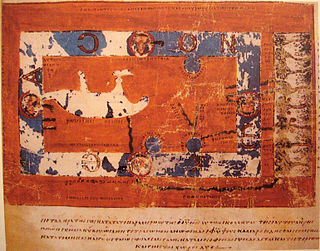 W
WCosmas Indicopleustes was a Greek merchant and later hermit from Alexandria of Egypt. He was a 6th-century traveller, who made several voyages to India during the reign of emperor Justinian. His work Christian Topography contained some of the earliest and most famous world maps. Cosmas was a pupil of the East Syriac Patriarch Aba I and was himself a follower of the Church of the East.
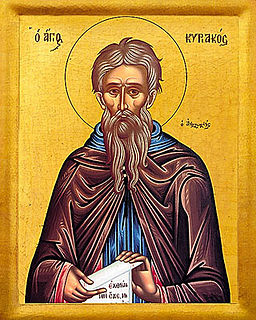 W
WSaint Kyriakos the Anchorite was born in Corinth in the year 448.
 W
WPope Damian of Alexandria, 35th Pope of Alexandria & Patriarch of the See of St. Mark.
 W
WPseudo-Dionysius the Areopagite was a Christian theologian and Neoplatonic philosopher of the late 5th to early 6th century, who wrote a set of works known as the Corpus Areopagiticum or Corpus Dionysiacum.
 W
WEutychius, considered a saint in the Catholic and Orthodox Christian traditions, was the patriarch of Constantinople from 552 to 565, and from 577 to 582. His feast is kept by the Orthodox Church on 6 April, and he is mentioned in the Catholic Church's "Corpus Juris". His terms of office, occurring during the reign of Emperor Justinian the Great, were marked by controversies with both imperial and papal authority.
 W
WHeraclius the Elder was a Byzantine general and the father of Byzantine emperor Heraclius. Of possible Armenian origin, Heraclius the Elder distinguished himself in the war against the Sassanid Persians in the 580s. As a subordinate general, Heraclius served under the command of Philippicus during the Battle of Solachon and possibly served under Comentiolus during the Battle of Sisarbanon. In circa 595, Heraclius the Elder is mentioned as a magister militum per Armeniam sent by Emperor Maurice to quell an Armenian rebellion led by Samuel Vahewuni and Atat Khorkhoruni. In circa 600, he was appointed as the Exarch of Africa and in 608, Heraclius the Elder rebelled with his son against the usurper Phocas. Using North Africa as a base, the younger Heraclius managed to overthrow Phocas, beginning the Heraclian dynasty, which would rule Byzantium for a century. Heraclius the Elder died soon after receiving news of his son's accession to the Byzantine throne.
 W
WHesychius of Alexandria was a Greek grammarian who, probably in the 5th or 6th century AD, compiled the richest lexicon of unusual and obscure Greek words that has survived, probably by absorbing the works of earlier lexicographers.
 W
WIsidore of Miletus was one of the two main Byzantine Greek architects that Emperor Justinian I commissioned to design the cathedral Hagia Sophia in Constantinople from 532 to 537. The creation of an important compilation of Archimedes' works has been attributed to him. The spurious Book XV from Euclid's Elements has been partly attributed to Isidore of Miletus.
 W
WJohn IV, also known as John Nesteutes, was the 33rd bishop or Patriarch of Constantinople. He was the first to assume the title Ecumenical Patriarch. He is regarded as a saint by the Eastern Orthodox Church which holds a feast on September 2.
 W
WJohn of Epiphania was a late sixth century Byzantine historian.
 W
WJulian of Halicarnassus was an anti-Chalcedonian theologian who contested with Severus of Antioch. His followers were known as the Aphthartodocetae. He lived in exile for a time in the monastery of the Enaton in Egypt.
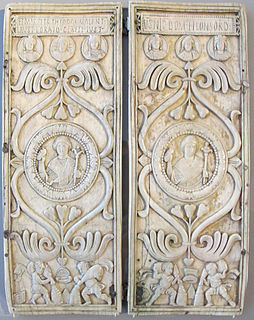 W
WFlavius Mar. Petrus Theodorus Valentinus Rusticius Boraides Germanus Iustinus, simply and commonly known as Justin, was an East Roman (Byzantine) aristocrat and general. A member of the Justinian Dynasty and nephew of Emperor Justinian I, he was appointed as one of the last Roman consuls in 540, before going on to assume senior military commands in the Balkans and in Lazica. He fought against the Slavs, the Sassanid Persians and supervised the Byzantine Empire's first contacts with the Avars. At the time of Justinian's death, he was seen as a probable successor, but was beaten to the throne by his cousin, Justin II, who exiled him to Egypt, where he was murdered.
 W
WTheodorus Lector was a lector, or reader, at the Hagia Sophia in Constantinople during the early sixth century. He wrote two works of history; one is a collection of sources which relates events beginning in 313, during Constantine's early reign, down to 439, during the reign of Theodosius II. The other is Theodorus' own work, retelling events from the death of Theodosius II in 450 to the beginning of Justin I's reign in 518. The former work is important to scholars editing the authors quoted by Theodorus; the latter exists only in fragment and owes its importance more to the "scantiness of our information concerning the period it treats rather than its merits."
 W
WMaximianus of Ravenna, or Maximian was bishop of Ravenna in Italy. Ravenna was then the capital of the Byzantine Empire's territories in Italy, and Maximianus's role may have included secular political functions.
 W
WMenas (Minas) considered a saint in the Eastern Orthodox Church, was Patriarch of Constantinople appointed by the Byzantine emperor Justinian I in 536. Pope Agapetus I consecrated him to succeed Bishop Anthimus, who was a monophysite. He took a position against Origen. He was excommunicated in 547 and in 551 for taking positions counter to those held by the Pope; but in both cases the sentence of excommunication was quickly lifted. Menas' patriarchy represents the greatest extent of papal influence in Constantinople.
 W
WFlavius Phocas was Eastern Roman emperor from 602 to 610. The early life of Phocas is largely unknown, but he rose to prominence in 602, as a leader in the revolt against Emperor Maurice. Phocas captured Constantinople and overthrew Maurice on 23 November 602, and declared himself emperor on the same day. Phocas deeply mistrusted the elite of Constantinople, and therefore installed his relatives in high military positions, and brutally purged his opponents. Phocas is widely regarded as an incompetent leader, both of the administration and army. Under his reign the Byzantine Empire was threatened by multiple enemies, with frequent raids in the Balkans from the Avars and Slavs, and a Sassanid invasion of the eastern provinces. Because of Phocas' incompetence and brutality, the Exarch of Africa, Heraclius the Elder, rebelled against him. Heraclius the Elder's son, Heraclius, succeeded in taking Constantinople on 5 October 610, and executed Phocas on the same day, before declaring himself the emperor.
 W
WZacharias of Mytilene, also known as Zacharias Scholasticus or Zacharias Rhetor, was a bishop and ecclesiastical historian.
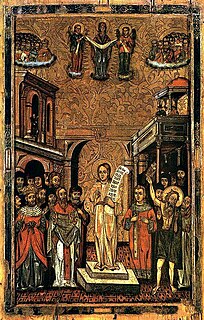 W
WSaint Romanos the Melodist or the Hymnographer was a notable Syrio-Greek hymnographer, called "the Pindar of rhythmic poetry". He flourished during the sixth century, which is considered to be the "Golden Age" of Byzantine hymnography.
 W
WSaint Sabbas the Sanctified (439–532), a Cappadocian-Syrian monk, priest and saint, lived mainly in Palaestina Prima. He was the founder of several convents, most notably the one known as Mar Saba. The saint's name is derived from Aramaic: סַבָּא Sabbāʾ "old man".
 W
WSeverus the Great of Antioch, also known as Severus of Gaza, was the Patriarch of Antioch, and head of the Syriac Orthodox Church, from 512 until his death in 538. He is venerated as a saint in the Oriental Orthodox Church, and his feast day is 8 February.
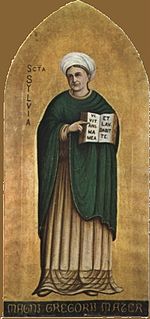 W
WSaint Silvia (Sylvia) was the mother of Saint Gregory the Great. She is venerated as a saint by the Catholic Church and Eastern Orthodox Church, which names her a patroness of pregnant women.
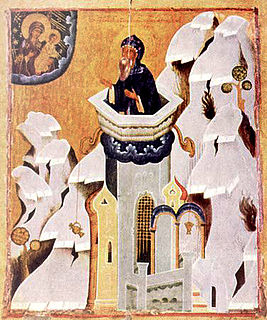 W
WSaint Simeon Stylites the Younger [also known as 'St. Simeon of the Admirable Mountain'] is a saint in the Eastern Orthodox Church and Catholic Churches of Eastern and Latin Rites. Born at Antioch, his father was a native of Edessa, his mother, named Martha was afterwards revered as a saint and a life of her, which incorporates a letter to her son written from his pillar to Thomas, the guardian of the true cross at Jerusalem, has been printed.
 W
WAelia Sophia was the Empress consort of Justin II of the Byzantine Empire, and regent during the incapacity of her spouse from 573 until 578. She was specifically interested in economic matters and was involved in financial matters during Justin's reign.
 W
WSophronius, called Sophronius the Sophist, was the Patriarch of Jerusalem from 634 until his death. He is venerated as a saint in the Eastern Orthodox and Catholic Churches. Before rising to the primacy of the see of Jerusalem, he was a monk and theologian who was the chief protagonist for orthodox teaching in the doctrinal controversy on the essential nature of Jesus and his volitional acts.
 W
WFlavius Strategius Apion Strategius Apion was a patrician and jurist of the Byzantine Empire, and the consul ordinarius of 539. He was a member of the wealthy and prominent Apion family of Oxyrhynchus, Egypt.
 W
WStylianos of Paphlagonia, also known as Stylianos the Hermit, is venerated as a saint from Adrianopolis in the province of Paphlagonia.
 W
WTheodora was an Eastern Roman empress by marriage to Emperor Justinian. She became empress upon Justinian's accession in 527 and was one of his chief advisers, albeit from humble origins. Along with her spouse, Theodora is a saint in the Eastern Orthodox Church and in the Oriental Orthodox Church, commemorated on 14 November and 28 June respectively.
 W
WSaint Theodore of Sykeon was a revered Byzantine ascetic, who lived between the first half of the 6th century and the thirteenth year of the Emperor Heraclius' rule in the early 7th century. His hagiography, written after 641, is a key primary source for the reign of Emperor Heraclius. His feast day is April 22.
 W
WTheodosius the Cenobiarch was a monk, abbot, and saint who was a founder and organizer of the cenobitic way of monastic life. His feast day is on January 11.
 W
WSaint Theophilus the Penitent or Theophilus of Adana was a cleric in the sixth century Church who is said to have made a deal with the Devil to gain an ecclesiastical position. His story is significant as it is the oldest story of a pact with the devil and was an inspiration for the Faust legend. Eutychianus of Adana, who claimed to be an eyewitness of the events, is the first to record Theophilus's story.
 W
WTribonian was a notable Byzantine jurist and advisor, who during the reign of the Emperor Justinian I, supervised the revision of the legal code of the Byzantine Empire.